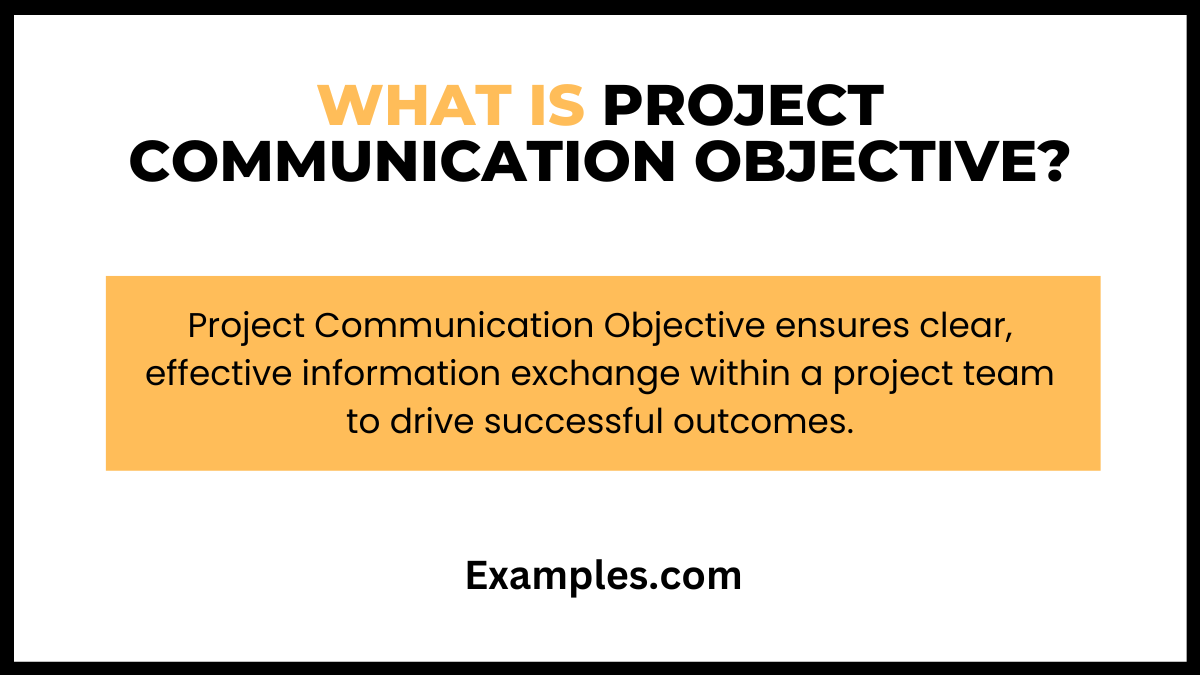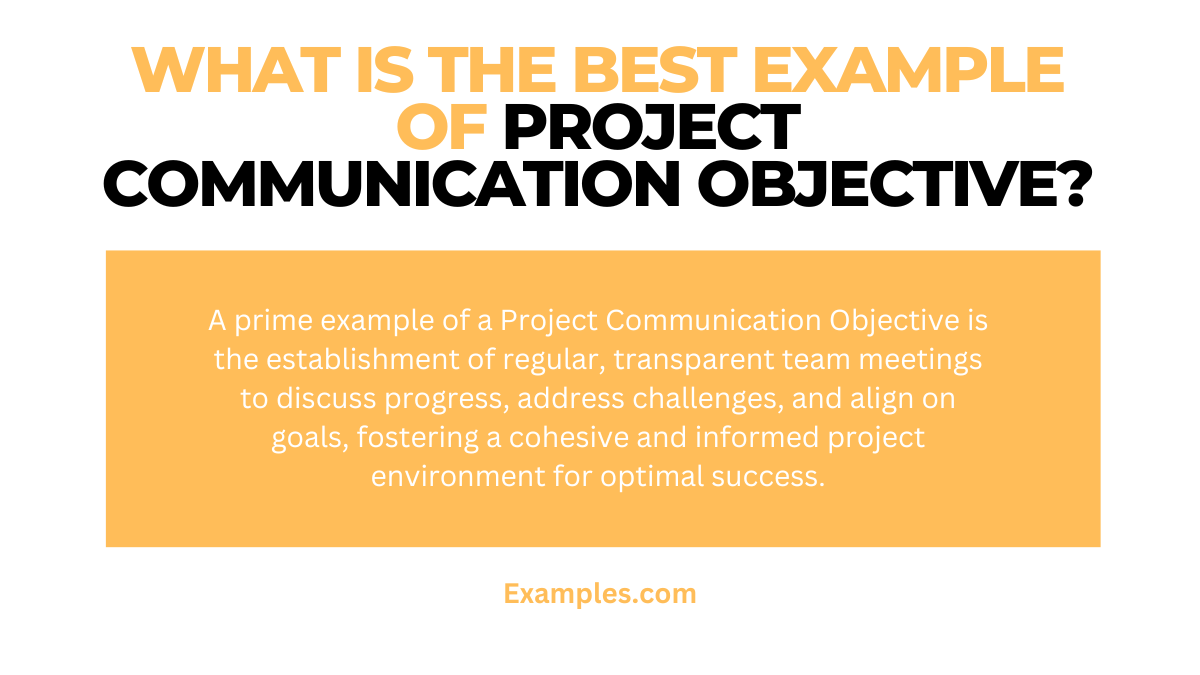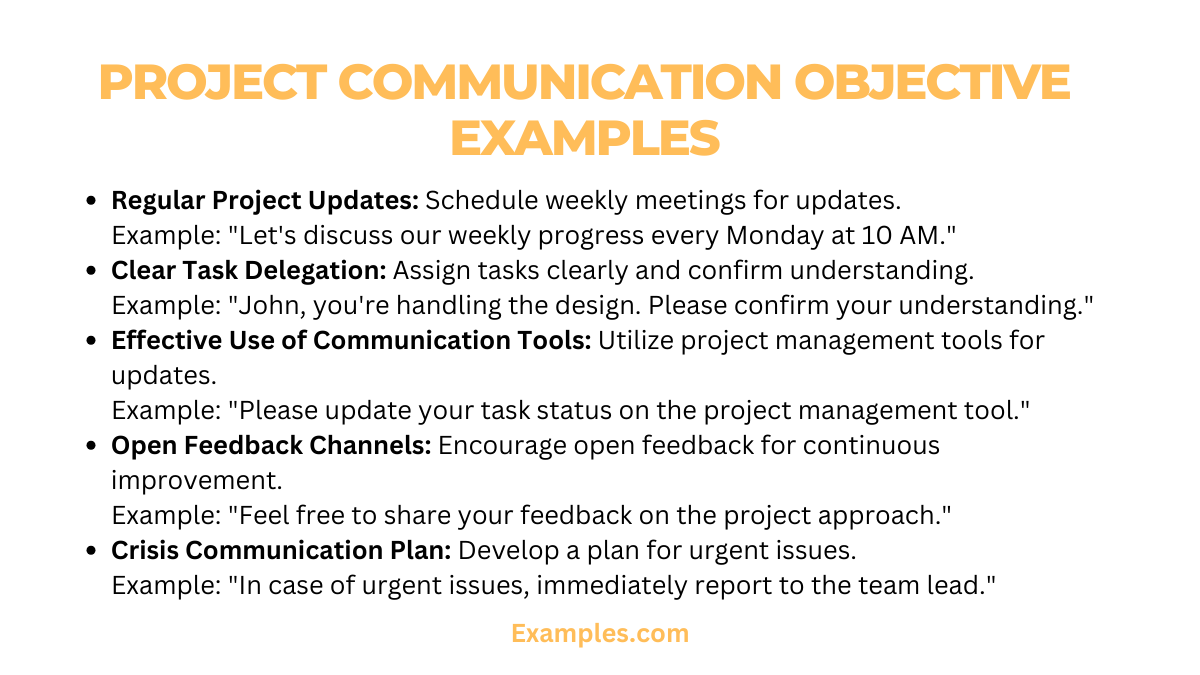19+ Project Communication Objectives Examples
Discover the essentials of Project Communication Objectives in our comprehensive guide, complete with practical and insightful examples. Understanding the right strategies for effective communication can significantly impact project success. This guide delves into various communication examples, illustrating how they can be skillfully applied in project scenarios. Enhance your team’s productivity and collaboration by mastering these communication techniques, tailored for project management excellence. Learn, adapt, and apply these principles to drive your project towards its goals.
What is Project Communication Objective?

A Project Communication Objective is a clear goal related to the exchange of information within a project. It defines what the project team aims to achieve in terms of communication. This includes ensuring that all project members are on the same page, that information is shared efficiently and effectively, and that there is clarity in all forms of communication within the project. The objective guides how communication is managed, making it a crucial element for the project’s success.
What is the Best Example of Project Communication Objective?

The best example of a Project Communication Objective is establishing a clear and consistent information flow among team members. This involves creating a structured plan where all project-related information, updates, and feedback are regularly communicated through designated channels. For instance, a team might set a weekly virtual meeting to discuss project progress and address any issues. This ensures that everyone is informed and aligned with the project’s goals and deadlines, thereby enhancing team coordination and reducing misunderstandings. Such a communication plan not only fosters transparency but also builds a strong foundation for teamwork and project success.
20 Project Communication Objective Examples

Project Communication Objectives are vital for ensuring efficient workflow and clarity among team members. They focus on establishing clear, consistent, and effective communication channels within a project. Good communication within a project is key to its success, as it helps in resolving issues, making decisions, and keeping everyone updated.
- Regular Project Updates: Schedule weekly meetings for updates.
Example: “Let’s discuss our weekly progress every Monday at 10 AM.” - Clear Task Delegation: Assign tasks clearly and confirm understanding.
Example: “John, you’re handling the design. Please confirm your understanding.” - Effective Use of Communication Tools: Utilize project management tools for updates. Example: “Please update your task status on the project management tool.”
- Open Feedback Channels: Encourage open feedback for continuous improvement.
Example: “Feel free to share your feedback on the project approach.” - Crisis Communication Plan: Develop a plan for urgent issues.
Example: “In case of urgent issues, immediately report to the team lead.” - Stakeholder Communication: Regularly update stakeholders about project status.
Example: “We will send monthly project reports to all stakeholders.” - Team Collaboration Encouragement: Foster a collaborative environment.
Example: “Let’s brainstorm solutions in our team meeting.” - Conflict Resolution Mechanism: Establish a process for resolving conflicts.
Example: “If any conflicts arise, refer them to the mediation team.” - Cultural Sensitivity in Communication: Respect cultural differences in team interactions. Example: “Be mindful of cultural holidays when scheduling meetings.”
- Transparent Decision-Making Processes: Share how decisions are made.
Example: “We decided on this approach based on client feedback.” - Regular Training on Communication Tools: Train team on new tools.
Example: “There will be a training session on the new communication software next week.” - Encouraging Constructive Criticism: Promote growth-oriented feedback.
Example: “Please provide constructive criticism to improve our project.” - Communication in Remote Work: Tailor communication for remote teams.
Example: “Let’s use video calls for more effective remote communication.” - Documenting Communication: Keep records of important discussions.
Example: “Please document the key points from today’s meeting.” - Setting Clear Communication Goals: Define specific communication objectives.
Example: “Our goal is to improve internal communication efficiency by 30%.” - Utilizing Visual Aids in Communication: Use visuals for clarity.
Example: “I’ve created a chart to explain this concept more clearly.” - Maintaining a Positive Tone: Keep communication encouraging.
Example: “Great job team, let’s keep up the good momentum.” - Ensuring Accessibility in Communication: Make information accessible to all.
Example: “Ensure all project documents are available in the shared drive.” - Feedback Loop for Continuous Improvement: Implement a feedback loop.
Example: “Your feedback is essential for us to improve our project execution.” - Balancing Formal and Informal Communication: Mix formal and casual interactions. Example: “While our emails are formal, let’s keep our team meetings casual and interactive.
Project Communication Objective Goals:
Project Communication Objective Goals are essential for guiding a project towards success. They act as benchmarks for evaluating how well information is shared and understood within the team. These goals focus on ensuring that communication is not only effective but also aligns with the project’s overall objectives. By setting specific communication goals, teams can enhance their collaboration, decision-making, and problem-solving abilities.
- Enhance Team Engagement: Aim to increase team involvement in discussions.
Example: “Let’s ensure everyone contributes their ideas in our next meeting.” - Improve Information Accuracy: Reduce misinformation and errors in communication. Example: “Double-check all data before sharing it in the report.”
- Speed Up Decision Making: Facilitate faster decision-making processes.
Example: “We need to streamline our decision-making in team meetings.” - Boost Project Transparency: Make project details and decisions more transparent.
Example: “All decisions and their rationales will be documented and shared with the team.” - Elevate Client Communication: Strengthen communication with clients for better satisfaction. Example: “Regular client updates will be part of our communication plan.”
- Promote Creative Problem Solving: Encourage innovative approaches through communication.
Example: “Let’s use our weekly meetings to brainstorm creative solutions.” - Foster Cross-Departmental Collaboration: Improve communication across different departments.
Example: “We’ll have joint sessions with the marketing team for better alignment.” - Streamline Communication Processes: Simplify communication channels and methods. Example: “We are implementing a new, more efficient communication system next month.”
- Cultivate a Feedback Culture: Regularly seek and provide constructive feedback.
- Example: “Feedback from all team members will be collected after each project phase.”
- Implement Regular Communication Training: Provide ongoing training on effective communication.
Example: “Quarterly communication workshops will be held to enhance our skills”.
Importance of Project Communication Objectives
Project Communication Objectives play a pivotal role in aligning team efforts towards common goals. Effective communication within a project ensures that every team member understands their responsibilities, project timelines, and the overall vision. This clarity leads to better decision-making, efficient problem-solving, and a cohesive team environment.
- Setting Clear Expectations: Establishes what is expected from each team member.
Example: “During our kickoff meeting, we’ll outline everyone’s roles and expectations.” - Facilitating Timely Updates: Ensures information is shared promptly.
Example: “We’ll have a quick daily stand-up meeting to share our progress and hurdles.” - Enhancing Team Collaboration: Promotes teamwork and unity.
Example: “Let’s use our collaboration platform for brainstorming and sharing ideas”. - Ensuring Stakeholder Involvement: Keeps stakeholders informed and involved.
Example: “We will have monthly stakeholder meetings to review project progress.” - Minimizing Misunderstandings: Reduces the chance of miscommunications.
Example: “Please confirm your understanding of the tasks assigned to you.” - Adapting to Project Changes: Communicates any alterations in the project plan.
Example: “Any changes in the project scope will be immediately communicated to all.” - Maintaining Project Focus: Keeps the team focused on the main objectives.
Example: “Regular reminders of our project goals will be sent to keep us aligned.” - Encouraging Feedback and Suggestions: Invites ideas for improvement.
Example: “Your suggestions for enhancing our project efficiency are always welcome.” - Building Trust within the Team: Creates an atmosphere of mutual trust.
Example: “Open and honest communication is key to building our team’s trust.” - Resolving Issues Efficiently: Facilitates quick resolution of problems.
Example: “Let’s discuss and resolve any issues in our weekly team meetings.
How to Create a Project Communication Objective Plan?

Creating a Project Communication Objective Plan is a strategic process that ensures all project members are aligned and informed. This plan is pivotal for project success, as it lays out the roadmap for how communication will be managed throughout the project lifecycle. Here’s a comprehensive guide to help you create an optimized plan:
- Identify Your Communication Needs: Begin by assessing the communication requirements of your project. Consider the size of your team, the complexity of the project, and the stakeholders involved.
- Define Clear Objectives: Establish specific communication objectives. These might include timely updates, ensuring stakeholder engagement, or maintaining transparent communication channels.
- Choose Appropriate Communication Tools and Channels: Select tools and channels that best suit your project needs. This could range from emails and meetings to project management software.
- Develop a Communication Schedule: Create a schedule that outlines when and how often communications will occur. This includes regular team meetings, stakeholder updates, and reporting intervals.
- Assign Roles : Clearly define who is responsible for various communication tasks. This ensures accountability and that all aspects of the communication plan are managed effectively.
- Feedback Integration: Include processes for gathering and responding to feedback from team members and stakeholders. This helps in continuously improving the communication strategy.
- Document the Plan: Ensure that your communication plan is documented and accessible to all project members. This serves as a reference and helps keep everyone aligned.
- Review and Adjust the Plan Regularly: Be open to modifying the plan as the project progresses. Flexibility is key to adapting to changes and maintaining effective communication.
In conclusion, Project Communication Objectives are vital for the smooth execution and success of any project. This guide, with its detailed examples and strategies, serves as a crucial resource for understanding and implementing effective communication plans. By prioritizing clear, consistent, and purposeful communication, teams can significantly enhance collaboration, efficiency, and project outcomes, ultimately leading to more successful project completions.



